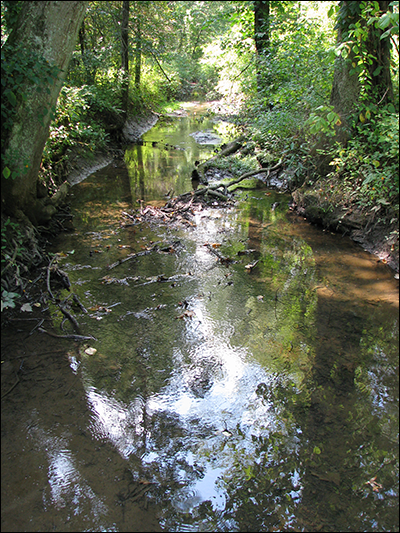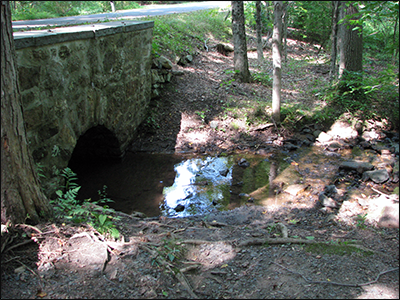

Bacteria monitoring site CMA 2 is located along Silver Brook at GSWA’s Conservation Management Area in Harding Township, NJ.
GSWA’s summer E. coli monitoring program has come to a close. After five weeks of monitoring bacteria in our streams and ponds, we have learned quite a bit. Here is a summary of the major findings:
- Some sites have very low levels of E. coli and meet the NJ State Standard in both dry and wet weather conditions. These sites are shown in green in the table below.
- Several sites have low levels of E. coli during dry periods, but E. coli levels exceed the NJ State Standard during and a few days after rain conditions. These sites are shown in yellow in the table below.
- Some sites do not meet the NJ State Standard in most dry or wet weather conditions. These sites are shown in red in the table below.
| Site Location | Site ID |
| Branta Pond, Somerset Environmental Education Center | EECBR |
| Bullfrog Pond, Somerset Environmental Education Center | EECBU |
| Lily Pad Pond, Somerset Environmental Education Center | EECLP |
| Primrose Brook off the Primrose Brook Trail downstream of the loop road, Jockey Hollow | PB4 |
| *Primrose Brook at the Grand Loop Trail bridge, Jockey Hollow | PB2 |
| Cat Swamp Pond off the NY Brigade Trail, Jockey Hollow | CSP |
| Black Brook upstream of Tanglewood Ln. in Chatham Township | BB2VA |
| Bayne Pond in Bayne Park, Harding Township | BN1 |
| Foote’s Pond off James St. in Morristown | GB6 |
| Loantaka Brook just downstream from Kitchell Pond | LB2M |
| Loantaka Brook just downstream from Ginty Pool in Morris Township | LB4M |
| Passaic River at Fisherman’s Parking Lot off Whitebridge Rd. in Bernards Township | PR0A |
| Passaic River off Columbia Turnpike at the Florham Park/Livingston border | CSE1 |
| Silver Brook in GSWA’s Conservation Management Area off the bridge between the blue and orange trails | CMA2 |
| Black Brook upstream from White Bridge Rd. in Long Hill Township, just west of Pleasant Plains Rd. | BB0 |
| Loantaka Brook upstream from Green Village Rd. in Chatham Township | AN0221 |
| Loantaka Brook at the end of Blue Stone Terrace in Morris Township | AN0220 |
* Indicates that the site’s category was changed due to an initial calculation error. GSWA regrets the errors.
To see all the results over the 5-week program, click here.
What Do the Results Mean?
Since E. coli indicates the presence of fecal matter, which could contain harmful viruses, you may want to avoid contact with water that has been contaminated. It is impossible to test E. coli levels every time a water body will be used, but we can learn from the patterns illustrated above and use them to inform our level of contact with water. For example, you may decide that making contact with water at the green sites is safe any time, or you may avoid contact with water at any of the red sites.
GSWA cannot make any recommendations regarding your personal interactions with waterways in our region, but you can use our data to make more informed decisions about when and how you come into contact.
What Now?


Bacteria monitoring site PB4 is located along Primrose Brook just downstream of the Loop Road at the Jockey Hollow Unit of Morristown National Historical Park.
Now that we have collected this data, follow-up will occur at a few sites where unusual patters were observed. Of the red sites, all are fairly far downstream, so the bacteria source may be hard to find given the extent of the search area. For now, we will focus our follow-up efforts on the Silver Brook in GSWA’s Conservation Management Area (CMA). The site is not too far downstream along the Silver Brook, so the search area for locating the contamination source is manageable. Our investigation can be limited to an area of land draining the CMA that is less than 1.5 square miles and just a bit more than 2 miles upstream.
Our follow up will require us to walk the stream and its tributaries to locations where there may be reason for changes in E. coli levels. (For example, the source could be a cluster of older homes with septic fields or a large mowed area that attracts geese.) Collecting water samples upstream and downstream of these potential sources and then analyzing them for E. coli will help us pinpoint where the high bacteria levels are coming from. Once we are confident of the source, we will work to reduce or eliminate it. How we reduce or eliminate the contamination depends on what we find.
Keep an eye on this blog for updates on what we find!
Note: the calculations were revised in 3-2015 due to a calculation error.